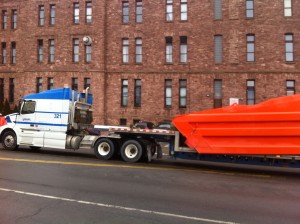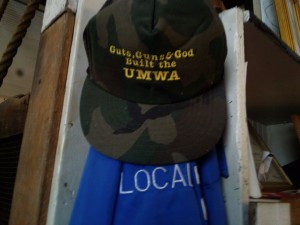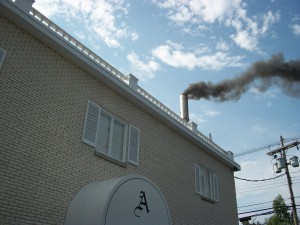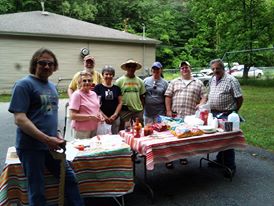A People’s Guide to the Draft Environmental Impact Statement
The Government plans on spending $28.5 Million on the West Side.

Want to know where trucks are being rerouted in your neighborhood?
Want to know how the project will impact your health?
Want to make sure you can still get to Front Park? To LaSalle Park?
Then join us on Tuesday December 10th for a Teach-In to learn:
- About the laws the Department of Transportation must follow, and the social movement that fought for them
- What the Department of Transportation is proposing to spend $28.5 Million on
- How to prepare public comments for the BIG public meeting on December 18th
Rides to and from the meeting are being provided! Call us at 716-852-3813 if you need a ride. Snacks will be served, and kids are welcome.
Department of Health Presents Final Tonawanda Cancer Study
TONAWANDA, NY – The New York State Department of Health will present the final results of their Tonawanda cancer study on Wednesday, November 6th at the Sheridan Parkside Community Center (169 Sheridan Parkside Dr.) in Tonawanda & on Thursday, November 7th at St. Timothy’s Church (1453 Staley Rd.) in Grand Island.
NYS DOH found that lung cancer, bladder cancer, and total cancers were elevated among both males and females; esophageal cancer was elevated among males and uterine cancer was elevated among females. In sub-areas, oral cavity was elevated among males, and leukemia among females. Pre-term births and heart defects were also elevated.
In their final report, the DOH included the recommendation to conduct future bio-monitoring of Tonawanda residents, including the taking of blood and urine samples to assess toxic exposure.
Tonawanda residents are requesting that any further health research must lead to change in public policy and regulation.
Tonawanda, NY has the highest concentration of air regulated facilities in the State. The community is extremely concerned about the high levels of different air pollutants from over 53 industrial plans in the neighborhood. According to the DEC, the annual average concentration for six air toxics (1,3-butadiene, acetaldehyde, acrolein, benzene, carbon tetrachloride, and formaldehyde), each exceed the health-based annual guideline concentrations.
Residents are calling on the Department of Health to take an active role to brief policy makers and asking the Department of Health to form a working group with the Department of Environmental Conservation focused on reducing toxic exposures.
“I think the State is hoping that cancer in Tonawanda is just going to go away,” said Durward Carter, Tonawanda resident, “It’s not going to. Cancer is linked to the pollution in our air. We need action.”
Both presentations will start at 7pm.
Amigone Calls Attorney General’s Lawsuit Frivolous
Amigone Funeral Home Inc. moved to dismiss a suit filed by the New York State Attorney Generals office, calling neighbors’ concerns– many who are elderly- frivolous. The crematory, which has a long history of generating offensive odors, soot and excessive noise, has been the source of persistent community complaints for decades.
“Even after reading sworn affidavits from 43 residents, Town of Tonawanda Board members, and reports from the Department of Environmental Conservation, the Amigones still don’t believe that their crematory causes a nuisance,” said Carol Fritsch, who lives close to the crematory. “I’m shocked.”
“It was a terrible smell, a stench.” States resident and veteran Norman Dehn in his affidavit, “Most of the time I smelled the odors in the evening.”
“The Crematory created problems for me.” Stated 97 year old resident Mary Calleri in her affidavit, “It made me more isolated because the odors forced me indoors. This happened too many times.”
Tonawanda residents are encouraged by the Attorney General’s suit especially in light of the Amigone’s recent statements indicating their intent to reopen. On August 12th, the Amigones along with their attorney and public relations consultant, met with 6 residents to discuss their intent to reopen. The family sent a letter to neighboring residents a few weeks later, indicating they intended to restart the crematory on the parcel next store to their current location.
“I felt abused when I was notified he wanted to reopen,” said neighbor Mary Ann Dickerson, “I don’t understand why a family business would operate this way, after knowing we’ve had to live with the smoke and smell coming from his operation.”
According to the suit, the Attorney General seeks injunctive relief against the Amigones to protect the public welfare and the environment. In his October 2nd press release Attorney General Schneiderman stated, “The Amigone crematory has cast a shadow of this Tonawanda community for too long. The crematory’s offensive nuisance emissions have long plagued residents, interfering with such basic pleasure as opening windows and enjoying backyards. This lawsuit will reassure this community that the Amigone crematory will never again pollute their air and disrupt their lives.”
Clean Air has been active in the fight to stop the crematory from operating next to homes, working closely with home owners in the densely populated community adjacent to Amigone’s Tonawanda location.
Motions will be heard by Judge Henry Nowak on November 6th at 9:30am in Erie County Supreme Court (25 Delaware Ave. Buffalo) Part 25. Residents will be available for comment.
Hearing on Tonawanda Coke Oct. 22rd
On March 28th, twelve jurors found Tonawanda Coke and its environmental control manager Mark Kamholz guilty on violating the Clean Air Act and Resource Conservation and Recovery Act (RCRA).
While we wait on a new sentencing date, the Department of Justice released a Government Sentencing Memorandum which makes recommendations for Tonawanda Coke to be sentenced as follows:
The Department of Justice also recommended 4 projects the community identified through Participatory Budgeting this past spring; including the Industrial Pollution Prevention Project; Citizen Science Lending Library; Worker and Community Toxics Education Project and the Riverside Tree Planting.
The sentencing of Tonawanda Coke is up to Judge William Skretny.
While there is no date on the calendar for sentencing, a hearing is scheduled for October 22, 2013 at 1:00PM before U.S. District Court Chief Judge William Skretny in the Federal Courthouse at 2 Niagara Square (9th floor), Buffalo, NY.
Stay tuned for updates as this case continues.
A copy of the full memorandum is available HERE.
Natasha Presents at Powershift 2013
This coming weekend organizer Natasha Soto is traveling to Pittsburgh to present on two panels at Power Shift 2013, a national conference for young organizers in the climate movement.
Power Shift 2013 will bring together leaders from the climate movement and beyond. The conference features keynote speeches from leaders from across the progressive movement, in-depth training and workshops on organizing.
Natasha will be presenting along with Jacqui Patterson (NAACP), LaTasha Mayes (New Voices Pittsburgh), Siwatu- Salama Ra (EMEAC) and Sachie Hopkins Hayakawa (Swarthmore Mountain Justice) on the panel “Environmental Justice 101”. The panel will discuss the definitions of environmental justice, examine EJ principles, and exchange views on how to create spaces that dismantle systemic oppression.
In addition to EJ 101, Natasha will join Julian Mocine-McQueen (Green For All), Elizabeth Reynoso (City Of Newark) and Tanya Field (The BLK Projek) on the panel “Green Economy and Careers: Building the Green Economy”, to share experiences on how to prepare for careers that have impact on the new economy.
Power Shift began in November 2007, when the Energy Action Coalition convened the first national youth climate summit in Washington DC. More than 6,000 young people from all 50 states gathered at the University of Maryland for a weekend of training and action. Since then the conference has grown and is coordinated by a coalition of 30 youth-led social and environmental justice organizations focused at taking on the climate crisis. This year in Pittsburgh organizers are expecting over 10,000 young leaders to attend.
Agents of Change: Clean Air Featured on Cover of ARTVOICE
Organizer Natasha Soto was featured on the October 3rd cover of ARTVOICE, highlighting our Participatory Budgeting campaign in Tonawanda & our work in neighborhoods bordering the Peace Bridge Plaza on Buffalo’s West Side.
Reporter Sarah Bishop interviews Natasha about her work using Participatory Budgeting as a way to change the decision making process and bring control to people who live in impacted neighborhoods.
Participatory budgeting (PB) is a democratic process in which community members directly decide how to spend part of a public budget
A little from the interview…
Soto: Don’t do for people what they can do for themselves. People who live in these neighborhoods have the answers, they are just never allowed to utilize them. They are continuously taken out of the decision-making process and people do things for them in “their best interest” without regard to them and without asking them what they would like in the first place. Participatory budgeting is a way for people in the neighborhood to have a say-so. Read the full interview here.
More Change Agents…
WATCH: Members Tangia Delk and Will Yelder joined Natasha on ARTVOICE TV to talk about why Participatory Budgeting matters.
During this interview Tangia and Will talked about their experience traveling to Chicago to attend the Second International Conference on Participatory Budgeting this past May.
“I think Participatory Budgeting is a thing to implement in the City of Buffalo, where I live.” said Tangia Delk, “There are a lot things in our community that only we see. Outside people don’t see because they just come through – back and forth to work- we live there.”
A.G. Schneiderman Sues To Prevent Reopening Of Amigone Funeral Home Crematory Over Persistent Environmental Violations
Crematory’s Odor, Soot And Noise Have Long Plagued Tonawanda Neighborhood
A.G.’s Suit Seeks To Block Operation Of Crematory In Residential Neighborhood
Schneiderman: This Lawsuit Will Reassure The Community That The Amigone Crematory Will Never Again Foul Their Air And Disrupt Their Lives
BUFFALO – Attorney General Eric T. Schneiderman and State Department of Environmental Conservation (DEC) Commissioner Joe Martens today announced a lawsuit to prevent Amigone Funeral Home Inc. from reopening its crematory in a residential neighborhood in the Town of Tonawanda, Erie County. The crematory, which has a long history of generating offensive odors, soot, and excessive noise into the neighborhood, has been the source of persistent community complaints. While a July 2012 agreement with Attorney General Schneiderman’s office resulted in Amigone suspending operations at the crematory, the funeral home has recently signaled its intention to restart operations.
“The Amigone crematory has cast a shadow over this Tonawanda community for too long,” Attorney General Schneiderman said. “The crematory’s offensive nuisance emissions have long plagued residents, interfering with such basic pleasures as opening windows and enjoying backyards. This lawsuit will reassure this community that the Amigone crematory will never again pollute their air and disrupt their lives. With this action, my office is standing with the residents of Tonawanda to protect their right to enjoy clean, fresh air.”
DEC Commissioner Joe Martens said, “The DEC referred this matter to the Attorney General for enforcement when it became clear that despite Amigone’s efforts, the crematory was causing a continuing violation of DEC laws and regulations. The Attorney General’s office worked closely with DEC staff to bring this action, and I congratulate their efforts to block the crematory from further impacting the neighboring community.”
The Attorney General’s lawsuit, which was filed in Erie County Supreme Court, charges that Amigone is unable to operate the crematory without violating state air pollution laws and creating a nuisance for nearby residents. The suit seeks to permanently block Amigone’s operation of the crematory at its Sheridan Drive property. The suit also seeks monetary penalties against Amigone for repeatedly violating state air pollution and other laws.
The Amigone crematory, which began operations in August 1991, is located adjacent to a quiet residential neighborhood. From the start, residents on and near Werkley Road have complained about the crematory’s odors, soot and excessive noise. Conditions worsened when the facility’s incinerator was replaced in July 2009. Residents have documented dark smoke emissions, denoting the release of particulates from cremation operations into the neighborhood, and DEC put the crematory on notice of serious violation of limits on emissions of smoke in May 2012.
Last July, Attorney General Schneiderman reached an agreement with Amigone that required closure of the facility for a six-month period while Amigone sought approval from the New York State Cemetery Board to relocate its crematory operation. The agreement further provided that if Amigone was unsuccessful in obtaining approval to relocate and wished to reopen during the six-month period, the company would need to retain a third-party expert to develop recommendations for operational changes that would address residents’ concerns about odors, soot, smoke, and noise.
The New York State Cemetery Board last year denied Amigone’s petition to relocate the crematory, and that determination was upheld in State Supreme Court this April. Although Amigone has taken public steps to recommence operations at its current site, it has provided no information regarding retaining an expert or developing any engineering plans to eliminate the crematory’s objectionable and illegal emissions.
Rebecca Newberry, Community Organizer, The Clean Air Coalition of W.N.Y., said, “The Clean Air Coalition applauds Attorney General Eric Schneiderman and his team in Buffalo for taking action to prevent the Amigone crematory from reopening. For years, the crematory’s neighbors were forced to live with the facility’s offensive odors, dark smoke and loud noise. We thank the AG’s office for defending the quality of life of these families.”
Attorney General Schneiderman thanks the Department of Environmental Conservation for their efforts in this matter.
The case is being handled by Assistant Attorneys General Jane Cameron and Michael Myers and staff scientist Jennifer Nalbone, under the supervision of Chief Scientist Alan Belensz, Deputy Bureau Chief Lisa M. Burianek, Bureau Chief Lemuel M. Srolovic, Executive Deputy Attorney General for Social Justice Alvin Bragg and First Deputy for Affirmative Litigation Janet Sabel. DEC Region 9 Attorney Maureen Brady and Environmental Engineers Alfred Carlacci and Alan Zylinski assisted in the case.
October 10th “What’s Happening in Appalachia”
This past June, Clean Air sent a delegation of members to Appalachia to meet with members of the Coalfield Environmental Health Project, a community organization made up of residents who live next to surface mining sites in Beards Fork,West Virginia.
For 3 days, our members learned first hand how residents are fighting coal companies who strip their land and pollute their wells and water sources.
The Coalfield Environmental Health Project was chosen as a sister group due to their experience successfully organizing around the connections between health and pollution. Residents who live near surface mining sites show a higher rate of heart disease, respiratory problems, cancer and birth defects.
On October 10th, our delegates will share their stories and what they learned during this intense and transformative experience.
Join us at 6pm at the River Rd. Volunteer Fire Hall (39 Kaufman Ave. Tonawanda NY 14150)
We Deserve Better
 All we were trying to do was submit comments to the Department of Transportation after their public scoping meeting, but we were not allowed. All we were trying to do was submit comments to the Department of Transportation after their public scoping meeting, but we were not allowed.On July 10th, one day before public comments were due for the NY Gateway Plans, Clean Air members and West Side residents, as well as some of our organizational partners, like Heart of the City Neighborhoods, PUSH Buffalo, and Coalition for Economic Justice, held a press conference telling Maria Lehman of the DOT that the West Side deserves better efforts of inclusivity. Even though we were promised fair and just public participation efforts, residents received short or no notice at all about the public scoping meeting; presentations, handouts, and relevant information regarding the project were all in English. To top it off, representatives at the meeting blamed the low turnout on the residents! We deserve better! We deserve to be included in the decisions that affect our neighborhood! Those decisions should not be made by people who do not live here, and that is exactly what we said outside the DOT before we tried to walk in and hand in our comments. Here’s a great video of members being denied entry into a public building. The next day the DOT announces that the public comment period has been extended until July 22- a big WIN for residents! It shouldn’t take a rally for the DOT to include residents in on the decisions that will affect their neighborhood, and potentially, their health. We shouldn’t have to fight for our public agencies to do the right thing. If you would like to learn more on our efforts to push for true inclusion on the West Side, you can call or email Natasha at 716-852-3813 or natasha@cacwny.org. Materials are available on the website in English and Espanol.  |
You can read our public comments to the DOT NY Gateway Connections Improvement Project, as well as comments from our members below:
Clean Air‘s Comments
Participatory Budgeting Results Are In!
On March 28th, twelve jurors found Tonawanda Coke Corporation and its environmental control manager Mark Kamholz guilty of violating the Clean Air Act and Resource Conservation and Recovery Act.
And together, in June, we made history when nearly 600 residents impacted by Tonawanda Coke cast a ballot for how to spend the settlement money.
This process is built off of the Participatory budgeting process. Participatory budgeting (PB) is a democratic process in which community members directly decide how to spend part of a public budget. PB was first developed in Brazil in the 1980s as part of a larger effort to establish democracy and citizen participation after decades of military dictatorship, political patronage and corruption. PB is now used throughout Latin America, a growing number of European Countries, New York City and Chicago. Learn more about PB here.
Here were the top results:
| Title | Description | Cost | Votes |
| Industrial Pollution Prevention Project | A project that will work with small to medium-sized manufacturers in the Tonawandas, Riverside, and Grand Island to reduce toxic chemical use, emissions, and waste, as well as improve the efficiency of energy, raw material, and water usage. | $250,000 | 260 |
| Community Environment Health Institute | The development of a long-standing community engaged environmental health institute targeted at research, training, prevention, and healthcare coordination to improve the health of WNY residents, especially those in areas affected by air pollution. | $15 million | 236 |
| Wickwire Park Redevelopment Project | The purchase and renovation of an approximately 40-acre site along the Niagara River for the purposes of providing waterfront access, historic re-use, job creation, and alternative energy generation. | $4 million | 217 |
| Tonawanda Area Environmental Health Study | A community-oriented study of environmental health in the Tonawanda region focusing on cancer incidences and air pollution exposure patterns. | $100,000 | 209 |
| Town of Tonawanda Tree Farms | The development of a new tree farm and model community garden in addition to the restocking of Old Town’s current tree farm and the eventual transplantation of trees throughout the Tonawanda area. | $150,000 | 209 |
Now it’s in the hands of the judge who will decide the company’s sentence. Up to $50 million could be spent here to fund these projects! We’ve sent the complete list of results to the Environmental Protection Agency and the Department of Justice. Together we have delivered a strong message that we want a healthier region and that we have great ideas on how to make that happen!
The Clean Air Coalition has led the charge against Tonawanda Coke – and the voting process. We could not have done this without our dedicated and courageous members. Who, with our staff, made over 3,000 get out the vote calls, sent over 2,000 pieces of mail, held a community assembly with over 100 residents, hosted 4 planning meetings, set up 12 voting locations and counted nearly 600 ballots.
Become a sustaining member of the Clean Air Coalition to help us keep going. With your generous membership gift of $25, $35 or $60 we can continue to be a force for environmental justice in our region.


